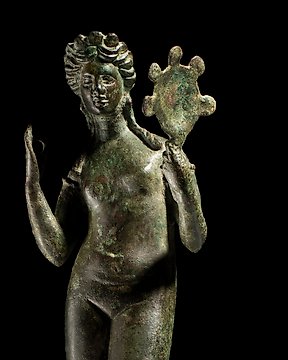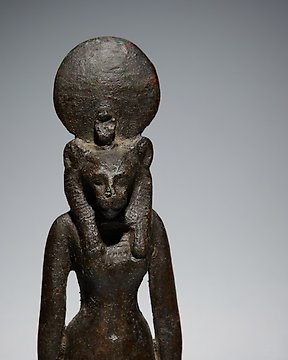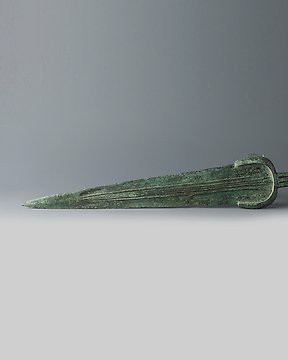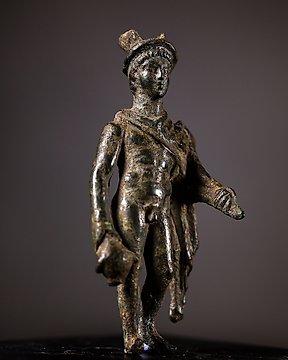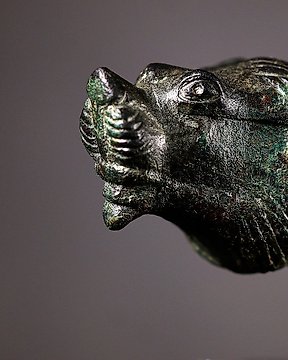All OK and with very fast shipping.
Fordítás megtekintéseEtruscan Bronz Fekvő szatír. Kr.e. 6-5. 5,5 cm Hossza. Spanyol kiviteli engedély.
Nr. 84871071

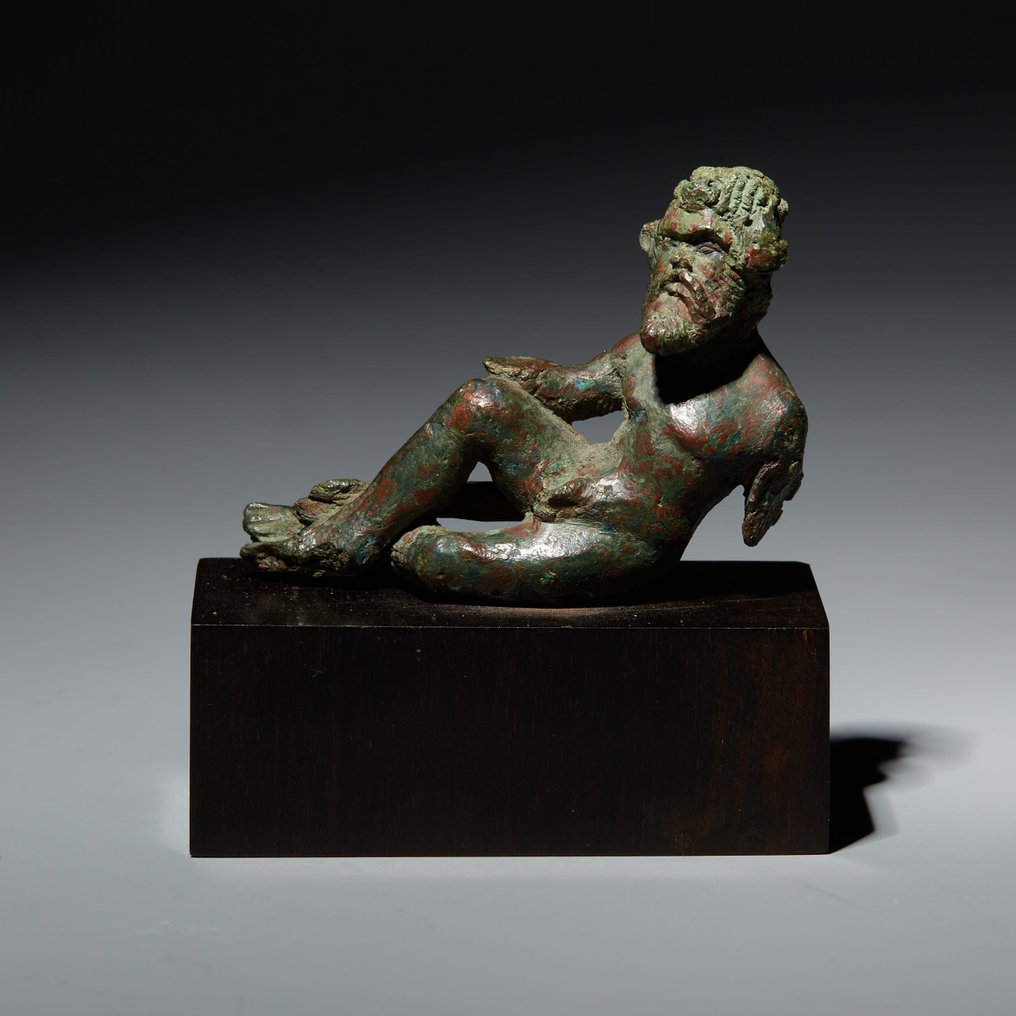
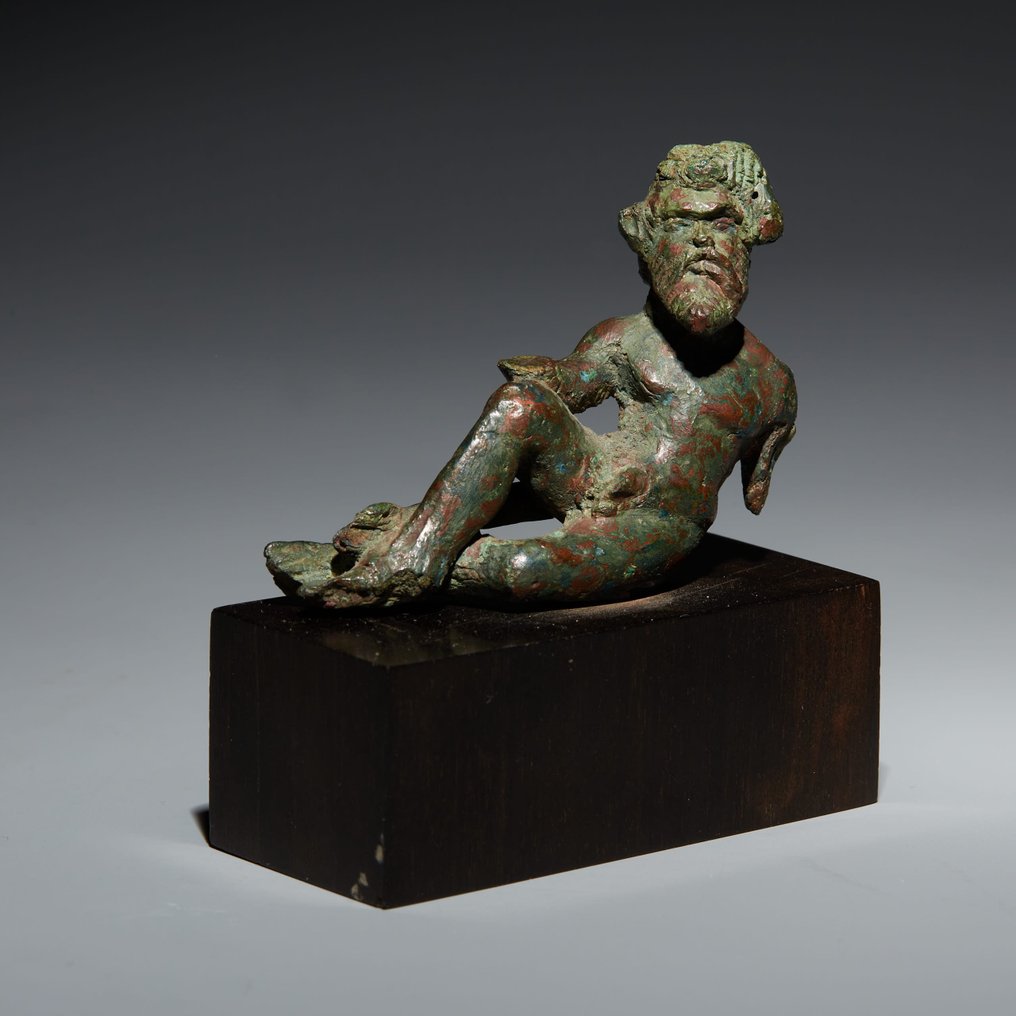
Reclining Satyr.
Etruscan, 6th - 5th century B.C.
Bronze
5.5 cm length, 4.2 cm height and 6.5 cm height with the stand.
CONDITION: Good condition. part of the arms are missing.
PROVENANCE: Private collection, Claude Bernard, Paris, France. 1970
DESCRIPTION:
Etruscan statuette of round bulk, cast in lost wax bronze, representing a satyr reclining, leaning on his left leg and arm, with his torso upright and legs crossed at the ankles. The sculptor follows the usual iconography for the representation of satyrs: naked and athletic body, with long animal tail, face with some animalistic features -in this case, the mule ears, the big mouth with thick lips and the pronounced frown-, long hair and dense beard. The character wears a headdress that covers the crown and the nape of the neck, and a medallion applied on the forehead. The satyr's expression is typically archaic, endowed with a serene hieratism that reflects his supernatural character, with the gaze of almond-shaped eyes fixed and the mouth closed, relaxed and expressionless. The posture, on the other hand, is dynamic in the way the body is posed, which turns to show itself almost frontally to the viewer, while the legs and the final plume of the tail cross, joining at the same point. The piece presents a beautiful patina of reddish and bluish tones on the green base.
The sculpture is worked with exquisite modeling, despite its small size; the richness and delicacy of detail, the careful work of the anatomy, the complexity of its composition and movement and, above all, the beautiful expression of the face, reveal the hand of a master sculptor. This great quality, together with the small size of the work, suggests that it could be a figurative applique belonging to a sumptuary object, perhaps for use in banquets, rituals or in combat. Given the chosen subject matter, it is most likely the applique of a vessel intended to contain wine, linked to the god Dionysus. In the British Museum there is a statuette, identified as a vase applique, with a composition very similar to that of the piece under study, although with a simpler sculptural work (fig. 1). Another from the same museum, also probably a vase applique, shows the satyr holding a reed flute (fig. 2).
Despite the modeling that moves towards naturalism, in line with contemporary Greek art, the statuette maintains the typically Etruscan physiognomy of the satyr: almond-shaped eyes with a fixed gaze, with a differentiated pupil and iris, a short, flat, rounded nose, and a mouth with thick lips. Also typical of the Etruscan satyr is the neat beard, with an almost geometric design and oval profile (fig. 3), as well as the same proportion of the figure, with an ideal, athletic and stylized body, in contrast with a head that is slightly large in comparison (fig. 4).
The Etruscans used metal to manufacture a wide range of objects, from purely functional, everyday objects, such as tools or weapons, to the most elaborate votive and sumptuary objects. A characteristic feature of Etruscan metal art, and especially of bronze, is the careful decoration that appears even on the most common objects. They were therefore highly appreciated outside Italy, as evidenced by the discovery of many of these objects in European sites, especially in Greece, where we find testimonies such as that of the Athenian tyrant Critias, who praised the quality of Etruscan metalwork, highlighting its libation bowls embossed in gold and its bronze ornaments for the house.
Satyrs are male creatures that in Greek mythology accompanied Pan and Dionysus, wandering through forests and mountains. They are associated with sexual appetite. Painters of ceramic vases used to represent them together with nymphs and maenads, sometimes with perpetual erections. They form the "Dionysian retinue" that accompanies the god Dionysus. A tradition considered that the sons of Silenus, called Maron, Leneus and Astreo, would have been the fathers of the satyrs. All three were in the retinue of Dionysus when he traveled to India and, in fact, Astreo was the driver of his chariot. Satyrs are merry and mischievous creatures, although their lighthearted and festive nature can turn dangerous and even violent. As Dionysian creatures, they are lovers of wine, women and enjoy physical pleasures.
This piece has been made using the lost wax technique, a sculptural procedure by which a mold is first made from a prototype, traditionally carved in beeswax. The previous model is surrounded by a thick layer of soft material that solidifies, usually clay; once hardened, it is placed inside an oven, which melts the wax figure, leaving it through holes created specifically for this purpose, and in its place, molten metal is injected to adopt the exact shape of the model. To extract the final piece it is necessary to remove the mold.
BIBLIOGRAPHY:
- BRENDEL, O. Etruscan Art. Yale University Press. 1995.
- HAYNES, S. Etruscan Civilizaton: A Cultural History. J. Paul Getty Museum, 2005.
- HAYNES, S. Etruscan Bronze Utensils. British Museum Publications. 1974.
- RICHTER, G. Greek, Etruscan and Roman Bronzes. Gilliss Press. 1915.
PARALLELS:
Fig. 1 Satyr statuette, probably an applique. Etruscan, ca. 475-450 B.C. Bronze, 3.81 cm high. British Museum, London, inv. 1859,0301.19.
Fig. 2 Satyr statuette, probably an applique. Etruscan, ca. 500-475 B.C. Bronze, 6.9 cm high. British Museum, London, inv. 1824,0466.1.
Fig. 3 Chariot applique with satyr's head. Etruscan, ca. 500-480 B.C. Bronze, 7.9 x 5.1 x 9.8 cm. Metropolitan Museum, New York, inv. 29.131.3s.
Fig. 4 Pair of reclining satyr statuettes, probably appliqués from the mouth of a vase. Etruscan, late 6th c. B.C. Bronze, 5 and 5.2 cm high. Metropolitan Museum, New York, inv. 1972.118.65-66.
Fig. 4 Pair of reclining satyr statuettes, probably appliqués from the mouth of a vase. Etruscan, late 6th c. B.C. Bronze, 5 and 5.2 cm high. Metropolitan Museum, New York, inv. 1972.118.65-66.
Notes:
The seller guarantees that he acquired this piece according to all national and international laws related to the ownership of cultural property. Provenance statement seen by Catawiki.
The seller will take care that any necessary permits, like an export license will be arranged, he will inform the buyer about the status of it if this takes more than a few days.
The piece includes authenticity certificate.
The piece includes Spanish Export License.
Az eladó története
Reclining Satyr.
Etruscan, 6th - 5th century B.C.
Bronze
5.5 cm length, 4.2 cm height and 6.5 cm height with the stand.
CONDITION: Good condition. part of the arms are missing.
PROVENANCE: Private collection, Claude Bernard, Paris, France. 1970
DESCRIPTION:
Etruscan statuette of round bulk, cast in lost wax bronze, representing a satyr reclining, leaning on his left leg and arm, with his torso upright and legs crossed at the ankles. The sculptor follows the usual iconography for the representation of satyrs: naked and athletic body, with long animal tail, face with some animalistic features -in this case, the mule ears, the big mouth with thick lips and the pronounced frown-, long hair and dense beard. The character wears a headdress that covers the crown and the nape of the neck, and a medallion applied on the forehead. The satyr's expression is typically archaic, endowed with a serene hieratism that reflects his supernatural character, with the gaze of almond-shaped eyes fixed and the mouth closed, relaxed and expressionless. The posture, on the other hand, is dynamic in the way the body is posed, which turns to show itself almost frontally to the viewer, while the legs and the final plume of the tail cross, joining at the same point. The piece presents a beautiful patina of reddish and bluish tones on the green base.
The sculpture is worked with exquisite modeling, despite its small size; the richness and delicacy of detail, the careful work of the anatomy, the complexity of its composition and movement and, above all, the beautiful expression of the face, reveal the hand of a master sculptor. This great quality, together with the small size of the work, suggests that it could be a figurative applique belonging to a sumptuary object, perhaps for use in banquets, rituals or in combat. Given the chosen subject matter, it is most likely the applique of a vessel intended to contain wine, linked to the god Dionysus. In the British Museum there is a statuette, identified as a vase applique, with a composition very similar to that of the piece under study, although with a simpler sculptural work (fig. 1). Another from the same museum, also probably a vase applique, shows the satyr holding a reed flute (fig. 2).
Despite the modeling that moves towards naturalism, in line with contemporary Greek art, the statuette maintains the typically Etruscan physiognomy of the satyr: almond-shaped eyes with a fixed gaze, with a differentiated pupil and iris, a short, flat, rounded nose, and a mouth with thick lips. Also typical of the Etruscan satyr is the neat beard, with an almost geometric design and oval profile (fig. 3), as well as the same proportion of the figure, with an ideal, athletic and stylized body, in contrast with a head that is slightly large in comparison (fig. 4).
The Etruscans used metal to manufacture a wide range of objects, from purely functional, everyday objects, such as tools or weapons, to the most elaborate votive and sumptuary objects. A characteristic feature of Etruscan metal art, and especially of bronze, is the careful decoration that appears even on the most common objects. They were therefore highly appreciated outside Italy, as evidenced by the discovery of many of these objects in European sites, especially in Greece, where we find testimonies such as that of the Athenian tyrant Critias, who praised the quality of Etruscan metalwork, highlighting its libation bowls embossed in gold and its bronze ornaments for the house.
Satyrs are male creatures that in Greek mythology accompanied Pan and Dionysus, wandering through forests and mountains. They are associated with sexual appetite. Painters of ceramic vases used to represent them together with nymphs and maenads, sometimes with perpetual erections. They form the "Dionysian retinue" that accompanies the god Dionysus. A tradition considered that the sons of Silenus, called Maron, Leneus and Astreo, would have been the fathers of the satyrs. All three were in the retinue of Dionysus when he traveled to India and, in fact, Astreo was the driver of his chariot. Satyrs are merry and mischievous creatures, although their lighthearted and festive nature can turn dangerous and even violent. As Dionysian creatures, they are lovers of wine, women and enjoy physical pleasures.
This piece has been made using the lost wax technique, a sculptural procedure by which a mold is first made from a prototype, traditionally carved in beeswax. The previous model is surrounded by a thick layer of soft material that solidifies, usually clay; once hardened, it is placed inside an oven, which melts the wax figure, leaving it through holes created specifically for this purpose, and in its place, molten metal is injected to adopt the exact shape of the model. To extract the final piece it is necessary to remove the mold.
BIBLIOGRAPHY:
- BRENDEL, O. Etruscan Art. Yale University Press. 1995.
- HAYNES, S. Etruscan Civilizaton: A Cultural History. J. Paul Getty Museum, 2005.
- HAYNES, S. Etruscan Bronze Utensils. British Museum Publications. 1974.
- RICHTER, G. Greek, Etruscan and Roman Bronzes. Gilliss Press. 1915.
PARALLELS:
Fig. 1 Satyr statuette, probably an applique. Etruscan, ca. 475-450 B.C. Bronze, 3.81 cm high. British Museum, London, inv. 1859,0301.19.
Fig. 2 Satyr statuette, probably an applique. Etruscan, ca. 500-475 B.C. Bronze, 6.9 cm high. British Museum, London, inv. 1824,0466.1.
Fig. 3 Chariot applique with satyr's head. Etruscan, ca. 500-480 B.C. Bronze, 7.9 x 5.1 x 9.8 cm. Metropolitan Museum, New York, inv. 29.131.3s.
Fig. 4 Pair of reclining satyr statuettes, probably appliqués from the mouth of a vase. Etruscan, late 6th c. B.C. Bronze, 5 and 5.2 cm high. Metropolitan Museum, New York, inv. 1972.118.65-66.
Fig. 4 Pair of reclining satyr statuettes, probably appliqués from the mouth of a vase. Etruscan, late 6th c. B.C. Bronze, 5 and 5.2 cm high. Metropolitan Museum, New York, inv. 1972.118.65-66.
Notes:
The seller guarantees that he acquired this piece according to all national and international laws related to the ownership of cultural property. Provenance statement seen by Catawiki.
The seller will take care that any necessary permits, like an export license will be arranged, he will inform the buyer about the status of it if this takes more than a few days.
The piece includes authenticity certificate.
The piece includes Spanish Export License.
Az eladó története
- 754
- 6
- 0
Prachtig schilderij. Zo blij mee. Zeer nette verkoper en zeer snelle levering.
Fordítás megtekintéseperfect ! very fast and high quality delivery !
Fordítás megtekintéseAll well! Thanks.
Fordítás megtekintéseVendeur très professionnel, top +++×
Fordítás megtekintésePhotos trop contrastées pour bien percevoir les défauts, mais ces défauts étaient visibles pour autant. Le "Bon état" est trompeur. Sinon, envoi rapide et correctement emballé. Frais de port exagérés.
Fordítás megtekintéseGreat communication, delivery and product. Came with a well made certificate of authenticity and good packaging. Overall very happy with the purchase! Delivery is a bit expensive, but I recommend it
Fordítás megtekintéseMagnifique témoin du passé, envoyé avec tous les justificatifs, impeccable. Encore une fois très satisfait, un grand merci
Fordítás megtekintéseThank you for the Special offer and the fast shipping of this excellent piece of art!
Fordítás megtekintésevery good description of the object, very good price for this rare item,. Fast sending (has been at my place 2 days after buying!). Definitely would buy again.
Fordítás megtekintéseSehr schön
Fordítás megtekintéseAs described, perfect logistic
Fordítás megtekintésegreat seller, everything came as should with certificate of authenticity
Fordítás megtekintéseExceptionally well packaged, description aligned with positing received
Fordítás megtekintéseReally precious, but without sound...
Fordítás megtekintésePainting well packed and rapidly sent!
Fordítás megtekintésesempre grande rapidità e professionalità
Fordítás megtekintéseparfait bien reçu, merci
Fordítás megtekintéseVery satisfied with the small Greek Lekythos. As always (we have already bought several items from Bagot), the object was wrapped and sent immediately and with the greatest care.
Fordítás megtekintésePerfect, excellent condition, good packaging, the parcel arrived without any problems… all is perfect as usual. Thank you very much and wait for an other nice piece like this one. Gilles.
Fordítás megtekintése+++ Top vendeur professionnel comme d'habitude
Fordítás megtekintéseEmbora o custo de transporte esteja acima da média foi, realmente, muito bem executado e em embalagem cuidada. Expeditos e profissionais. Recomendo
Fordítás megtekintéseSnel en correct en goed verpakt verzonden
Fordítás megtekintéseoggetto bellissimo, fedele alla descrizione, venditore affidabile
Fordítás megtekintéseVery nice piece and fast delivery
Fordítás megtekintése- 754
- 6
- 0
All OK and with very fast shipping.
Fordítás megtekintéseLemondás
Az eladó garantálja, hogy a tárgy a jogszabályoknak megfelelően került hozzá, és ezt bizonyítani is tudja. Az eladó kapott információt a Catawikitől arról, hogy a tárgyhoz mellékelnie kell a tartózkodási helyének megfelelő jogszabályok alapján szükséges dokumentációt. Az eladó garantálja a tárgy eladását/exportját és jogában áll mindez. Az eladó minden a tárggyal kapcsolatban szükséges információt továbbít a vevőnek. Az eladó biztosítja, hogy minden szükséges engedély el lett/lesz intézve. Az eladó azonnal tájékoztatja a vevőt, amennyiben az engedélyek beszerzése késik.
Az eladó garantálja, hogy a tárgy a jogszabályoknak megfelelően került hozzá, és ezt bizonyítani is tudja. Az eladó kapott információt a Catawikitől arról, hogy a tárgyhoz mellékelnie kell a tartózkodási helyének megfelelő jogszabályok alapján szükséges dokumentációt. Az eladó garantálja a tárgy eladását/exportját és jogában áll mindez. Az eladó minden a tárggyal kapcsolatban szükséges információt továbbít a vevőnek. Az eladó biztosítja, hogy minden szükséges engedély el lett/lesz intézve. Az eladó azonnal tájékoztatja a vevőt, amennyiben az engedélyek beszerzése késik.



